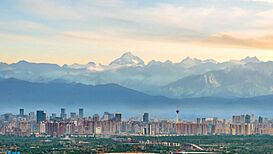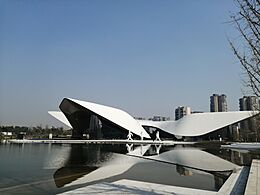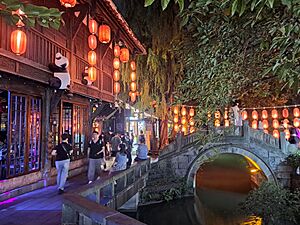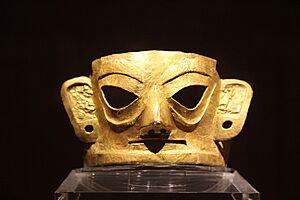Chengdu facts for kids
Quick facts for kids
Chengdu
成都
Chengtu
|
||
|---|---|---|
|
Prefecture-level and sub-provincial city
|
||
| City of Chengdu | ||
|
Chengdu skyline with snowcapped mountains
Taikoo Li
Financial City
Chengdu skyline overlooking the Jin River
Chengdu Research Base of Giant Panda Breeding
Anshun Bridge
|
||
|
||
| Nicknames:
Hibiscus City, Brocade City, Turtle City, Cheng'msterdam
|
||
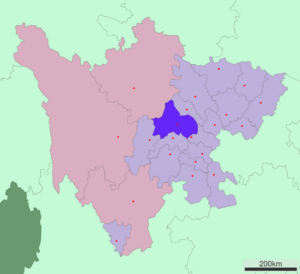
Location of Chengdu City jurisdiction in Sichuan
|
||
| Country | China | |
| Province | Sichuan | |
| Established | 4th century BC | |
| Municipal seat | Wuhou District | |
| Divisions - County-level |
12 districts, 5 county-level cities, 3 counties |
|
| Government | ||
| • Type | Important city in China | |
| Area | ||
| • Prefecture-level and sub-provincial city | 14,378.18 km2 (5,551.45 sq mi) | |
| • Urban | 3,679.9 km2 (1,420.8 sq mi) | |
| • Metro | 4,558.8 km2 (1,760.2 sq mi) | |
| • Downtown | 465.88 km2 (179.88 sq mi) | |
| Elevation | 500 m (1,600 ft) | |
| Highest elevation | 5,364 m (17,598 ft) | |
| Lowest elevation | 378 m (1,240 ft) | |
| Population
(2020 census)
|
||
| • Prefecture-level and sub-provincial city | 20,937,757 | |
| • Density | 1,456.2175/km2 (3,771.5860/sq mi) | |
| • Urban | 15,419,445 | |
| • Urban density | 4,190.18/km2 (10,852.52/sq mi) | |
| • Metro | 16,045,577 | |
| • Metro density | 3,519.69/km2 (9,115.96/sq mi) | |
| • Major Ethnic group | Han | |
| GDP | ||
| • Total | CN¥ 2.207 trillion US$ 325 billion |
|
| • Per person | CN¥ 103,500 US$ 15,250 |
|
| Time zone | UTC+08:00 (China Standard) | |
| Postal code |
610000–611944
|
|
| Area code(s) | (0)28 | |
| ISO 3166 code | CN-SC-01 | |
| License Plate Prefix | 川A and 川G | |
| Tree | Ginkgo biloba | |
| Flower | Hibiscus mutabilis | |
| HDI (2015) | 0.791 (21st) – high | |
| Chengdu | |||||||||||||||||||||||||||||||||||||||
|---|---|---|---|---|---|---|---|---|---|---|---|---|---|---|---|---|---|---|---|---|---|---|---|---|---|---|---|---|---|---|---|---|---|---|---|---|---|---|---|

"Chengdu" in Chinese characters.
|
|||||||||||||||||||||||||||||||||||||||
| Chinese | 成都 | ||||||||||||||||||||||||||||||||||||||
| Hanyu Pinyin | Chéngdū | ||||||||||||||||||||||||||||||||||||||
|
|||||||||||||||||||||||||||||||||||||||
| Postal | Chengtu | ||||||||||||||||||||||||||||||||||||||
| Literal meaning | "The Established Capital City" | ||||||||||||||||||||||||||||||||||||||
|
|||||||||||||||||||||||||||||||||||||||
| Former name | |||||||||||||||||||
|---|---|---|---|---|---|---|---|---|---|---|---|---|---|---|---|---|---|---|---|
| Xījīng | |||||||||||||||||||
| Chinese | 西京 | ||||||||||||||||||
| Literal meaning | Western Capital | ||||||||||||||||||
|
|||||||||||||||||||
| Nicknames | |||||||||||||||||
|---|---|---|---|---|---|---|---|---|---|---|---|---|---|---|---|---|---|
| City of Brocade | |||||||||||||||||
| Traditional Chinese | 錦城 | ||||||||||||||||
| Simplified Chinese | 锦城 | ||||||||||||||||
| Literal meaning | Brocade City | ||||||||||||||||
|
|||||||||||||||||
| City of Hibiscus | |||||||||||||||||
| Chinese | 蓉城 | ||||||||||||||||
| Literal meaning | Hibiscus City | ||||||||||||||||
|
|||||||||||||||||
Chengdu is the capital city of Sichuan province in China. It is a huge city, home to over 20 million people. This makes it the fourth most populated city in all of China! Chengdu is known as an important center in Western China.
The city is located in the middle of Sichuan, on a flat area called the Chengdu Plain. This area is often called the "Country of Heaven" or "Land of Abundance" because of its rich soil. Long ago, people from the Sanxingdui culture lived here. A very old water system called Dujiangyan is also nearby. It is so special that it's a World Heritage Site. The Jin River flows right through Chengdu.
Chengdu's culture is very similar to the rest of Sichuan. In 2011, UNESCO even called it a "City of Gastronomy" because of its amazing food! The city is also famous for giant pandas. These pandas are a symbol of China, and many live in Sichuan. Chengdu has a special place called the Chengdu Research Base of Giant Panda Breeding where pandas are cared for.
Chengdu was founded by the Kingdom of Shu way back in the 4th century BC. What's really cool is that Chengdu is one of the only major cities in China that has kept its original name for over 2,000 years! It was once the capital of Liu Bei's Shu Han Empire during the Three Kingdoms period. During World War II, many people from eastern China came to Chengdu to escape the fighting. Today, Chengdu is a very important city for business, culture, and transportation in China.
Contents
- What's in a Name?
- City Logo
- A Look Back: Chengdu's History
- Chengdu's Location and Climate
- How Chengdu is Organized
- Cityscape: Modern Marvels
- People of Chengdu
- Culture: Fun and Food
- Main Sights: Places to Explore
- Chengdu's Economy: A Growing City
- Getting Around: Transport in Chengdu
- Learning in Chengdu: Education and Research
- International Connections: Consulates
- Sports in Chengdu
- Sister Cities
- Notable People from Chengdu
- See also
What's in a Name?
The name Chengdu has been used for a very long time. It's one of the few big cities in China that has kept its name for thousands of years. One old story says the name comes from a king who said a settlement needed "one year to become a town, two to become a city, and three to become a metropolis." The Chinese characters for Chengdu mean "turned into a metropolis."
Chengdu also has some cool nicknames! It's called the "Turtle City" because its old city walls looked like a turtle on a map. It's also known as the "Brocade City" because of its beautiful silk fabrics. Another nickname is the "Hibiscus City," after the hibiscus flowers that a king ordered to be planted on the city walls many centuries ago.
City Logo
The city's logo, chosen in 2011, is inspired by the Golden Sun Bird. This is an ancient golden artifact found in 2001 at the Jinsha Site.
A Look Back: Chengdu's History
Scientists have found old settlements around Chengdu that are over 4,000 years old! These discoveries at the Sanxingdui and Jinsha Site show that a unique Bronze Age culture lived here. This culture was known as Shu.
Ancient Times: From Shu to Han Dynasties
The ancient Shu Kingdom on the Chengdu Plain had a well-developed bronze culture. It was an important part of early Chinese civilization. Around the 4th century BC, King Kaiming moved his capital to Chengdu. This is why Chengdu is one of the few cities in the world that has kept its name for so long. You can still see many ancient Shu relics in Chengdu today, like the Sanxingdui and Jinsha Ruins.
The Qin state conquered Shu in 316 BC. A general named Zhang Yi rebuilt the city walls of Chengdu. Later, in 256 BC, a governor named Li Bing built the amazing Dujiangyan Irrigation System. This system still works today! It made the Chengdu Plain very fertile, earning it the name "Land of Abundance."
During the Han dynasty, Chengdu became very rich, especially from making beautiful silk fabrics called brocade. The government even set up a special office to manage brocade production. Chengdu grew to be one of the biggest cities in China at that time, with hundreds of thousands of people. It also had the world's first public school run by the local government. Many famous writers and artists came from Chengdu during the Han dynasty.
Imperial Era: Emperors and Poets

After the Han dynasty, Liu Bei made Chengdu the capital of his Shu Han kingdom during the Three Kingdoms period. His smart advisor, Zhuge Liang, called the area the "Land of Abundance."
During the Tang dynasty, Chengdu was one of the most successful cities in China. Famous poets like Li Bai and Du Fu lived here. Du Fu even had a small "Grass Hall" in the city, which is now a museum. The ancient Taoist Qingyang Gong (Green Goat Temple) was also built around this time.
Later, Chengdu was the capital of the Former Shu and Later Shu kingdoms. A king named Meng Chang made the city even more beautiful by planting hibiscus flowers all over the city walls.
The Song dynasty took over in 965. This is when the world's first widely used paper money was created in Chengdu! Later, during the Yuan dynasty, the famous traveler Marco Polo visited Chengdu and wrote about the Anshun Bridge.
Modern Times: War and Growth
In 1911, a movement in Chengdu helped start the revolution that ended the Qing dynasty.
During World War II, China's capital had to move inland to escape the Japanese army. Chengdu became an important place for the Chinese government and military. Japanese planes often bombed the city, but Chinese pilots bravely defended it.
Later, American planes also used Chengdu as a base to bomb Japan. This was a big step in fighting back against the Japanese homeland.

After the war, Chengdu was the last city on mainland China held by the Nationalist government before they moved to Taiwan. In 1949, Communist forces took control of the city.
Today, Chengdu is still growing fast. There are plans for a new, green city called the "Great City" nearby. It's designed so people can walk everywhere, reducing the need for cars. The goal is to make Chengdu a "city within a park," focusing on nature and a good quality of life.
Chengdu's Location and Climate
Chengdu is located on a large, flat plain in western Sichuan. High mountains, like the Longmen Mountains and Qionglai Mountains, surround it to the northwest and west. These mountains are home to giant pandas and beautiful forests. To the east, there are lower mountains.
The city is known as the "Abundant Land" because of its fertile soil, good weather, and the ancient Dujiangyan Irrigation System. Several rivers, like the Jin, Fu, and Sha Rivers, flow through the city.
Chengdu has a warm, humid climate all year round. It has four distinct seasons. Winters are mild because mountains protect the city from cold winds. Summers are hot and humid, but not as extreme as some other Chinese cities. Most of the rain falls in July and August. Chengdu also has less sunshine than many other places, often feeling cloudy.
How Chengdu is Organized
Chengdu is a large city with many parts. It is divided into 12 districts, 5 county-level cities, and 3 counties.
| Administrative divisions of Chengdu | |||||||||||
|---|---|---|---|---|---|---|---|---|---|---|---|

Jinjiang
Qingyang
Jinniu
Wuhou
Chenghua
Longquanyi
Qingbaijiang
Xindu
Wenjiang
Shuangliu
Pidu
Xinjin
Jintang
County Dayi
County Pujiang
County Dujiangyan
(city) Pengzhou
(city) Qionglai
(city) Chongzhou
(city) Jianyang
(city) |
|||||||||||
| Code | Area | Area in km2 | Population 2020 | Main Office | |||||||
| 510100 | Chengdu | 14,378.18 | 20,937,757 | Wuhou | |||||||
| 510104 | Jinjiang | 60.24 | 902,933 | Chenglong Road Subdistrict | |||||||
| 510105 | Qingyang | 65.89 | 955,954 | Xinhua West Road Subdistrict | |||||||
| 510106 | Jinniu | 107.03 | 1,265,398 | Fuqin Subdistrict | |||||||
| 510107 | Wuhou | 123.44 | 1,855,186 | Jiangxi Street Subdistrict | |||||||
| 510108 | Chenghua | 109.28 | 1,381,894 | Mengzhuiwan Subdistrict | |||||||
| 510112 | Longquanyi | 558.74 | 1,346,210 | Longquan Subdistrict | |||||||
| 510113 | Qingbaijiang | 392.41 | 490,091 | Hongyang Subdistrict | |||||||
| 510114 | Xindu | 480.65 | 1,558,466 | Xindu Subdistrict | |||||||
| 510115 | Wenjiang | 276.91 | 967,868 | Liucheng Subdistrict | |||||||
| 510116 | Shuangliu | 1,067.83 | 2,659,829 | Dongsheng Subdistrict | |||||||
| 510117 | Pidu | 437.45 | 1,672,025 | Pitong Subdistrict | |||||||
| 510132 | Xinjin | 329.93 | 363,591 | Wujin Subdistrict | |||||||
| Urban District | 3679.87 | 15,419,445 | |||||||||
| 510121 | Jintang County | 1,155.60 | 800,371 | Zhaozhen Subdistrict | |||||||
| 510129 | Dayi County | 1,318.80 | 515,962 | Jinyuan Subdistrict | |||||||
| 510131 | Pujiang County | 579.17 | 255,563 | Heshan Subdistrict | |||||||
| 510181 | Dujiangyan | 1,207.98 | 710,056 | Guankou Subdistrict | |||||||
| 510182 | Pengzhou | 1,419.38 | 780,399 | Tianpeng Town | |||||||
| 510183 | Qionglai | 1,384.44 | 602,973 | Linqiong Subdistrict | |||||||
| 510184 | Chongzhou | 1,088.01 | 735,723 | Chongyang Subdistrict | |||||||
| 510185 | Jianyang | 2,215.02 | 1,117,265 | Jiancheng Subdistrict | |||||||
Cityscape: Modern Marvels
Chengdu is home to some amazing buildings. The New Century Global Center is here. It's the world's largest building by floor area! It's huge, with shops, cinemas, offices, hotels, and even a water park with an artificial beach.
- Gallery
People of Chengdu
Chengdu is a very populated city. In 2020, over 20 million people lived there. It is the biggest city in Sichuan province and the fourth largest in China. The population keeps growing, with many people moving to Chengdu each year.
Culture: Fun and Food
China Daily once called Chengdu China's fourth-most-livable city. This means it's a great place to live!
Literature and Art
Chengdu has a rich history of literature. Many famous Chinese writers and poets, like Li Bai and Du Fu, lived here. Chengdu also hosted the 81st World Science Fiction Convention in 2023, which was a big event for sci-fi fans!
In terms of art, a special style of painting called "Fine-Brush Flower-and-Bird Painting" started in Chengdu during the Five Dynasties period.
Religion in Chengdu
Chengdu has different religious groups, including Christian (Catholic and Protestant) and Jewish communities. People practice their faiths in various churches and centers across the city.
Theater: Sichuan Opera
Sichuan opera is very famous. People say "Shu opera towers above all other performances in the world." It's an ancient type of show with singing, dancing, and comedy. Sichuan opera is known for its amazing "face-changing" masks and fire breathing!
Food and Tea Culture
Sichuan cuisine is famous for being spicy, especially with chilies and peppercorns. Some popular dishes include Mapo doufu, Chengdu Hot pot, and Dan Dan Mien. Chengdu is officially recognized by UNESCO as a City of Gastronomy.
Chengdu is also known as "China's party city" because of its relaxed lifestyle. It has more tea houses and bars than many other big cities in China. Chengdu's tea culture is over a thousand years old.
Teahouses
Teahouses are everywhere in Chengdu. They can be fancy places with bamboo furniture or simple modern spots. People go there to drink tea, play mahjong, get massages, or even watch Sichuan opera.
Hot Pot
Chengdu is famous for its hot pot. This traditional dish involves cooking vegetables, fish, or meat in a boiling, spicy broth. It's a popular meal for friends and family to share.
Mahjong: A Local Favorite
Mahjong is a huge part of daily life in Chengdu. After work, people gather at home or in teahouses to play. On sunny days, you'll even see people playing outside on the sidewalks. Locals enjoy it because the rules are simpler than other versions, and it's a great way to socialize and spend time with loved ones. Some even believe it helps keep their minds sharp!
Rural Tourism: Nong Jia Le
Chengdu is known for starting "Nong Jia Le," which means "Happy Rural Homes." This is where people in the countryside turn their homes into restaurants, hotels, and fun places for city people to visit. It's a way for city dwellers to escape the busy city, enjoy homemade food, and play mahjong in a relaxed setting.
Main Sights: Places to Explore
World Heritage Sites
Mount Qingcheng
Mount Qingcheng is a very important Taoist site in China. It's about 70 km from Chengdu. The mountain is cool and green all year, with beautiful temples like Fujian Temple and Tianshi Cave.
Dujiangyan Irrigation System
The Dujiangyan Irrigation System is about 58 km from Chengdu. It's the oldest working irrigation project in the world, built over 2,000 years ago! It helps control floods and droughts on the Chengdu Plain without needing a dam.
Sichuan Giant Panda Sanctuaries
The Sichuan Giant Panda Sanctuaries cover a huge area and are home to over 80% of the world's wild giant pandas. It's the largest continuous habitat for pandas. The Wolong Nature Reserve, often called the "homeland of pandas," is part of this area.
History and Culture
Wuhou Shrine
Wuhou Shrine is a famous museum about the Three Kingdoms period. It honors Zhuge Liang, a brilliant strategist, and Liu Bei, the founder of the Shu Han state. You can see statues and old relics here.
Du Fu Thatched Cottage
Du Fu was one of China's most famous poets. He lived in a small thatched cottage by the Huanhua Stream in Chengdu for four years. Today, it's a memorial with gardens, halls, and a collection of his poems.
Ancient Shu Civilization
Jinsha Site
The Jinsha Site is a major archaeological discovery from 2001. The Jinsha Relics Museum shows off ancient artifacts found here, like the famous Golden Sun Bird.
Golden Sun Bird
The Golden Sun Bird is a beautiful gold artifact found at the Jinsha Ruins. It's a thin, round plaque from 210 BC. It has four birds flying around the edge, representing the four seasons, and a sun in the middle with 12 rays, representing the 12 months. It's so old and detailed! In 2005, it became the official logo for Chinese cultural heritage.
Sanxingdui Museum
The Sanxingdui Museum is another important place to learn about ancient Shu culture. It's much larger now, with over 2,000 precious items like bronze, jade, and gold objects. It shows how advanced the ancient Shu civilization was.
Buddhist and Taoist Culture
Daci Temple
The Daci Temple is an old temple in downtown Chengdu, first built long ago during the Wei and Jin dynasties. A famous monk named Xuanzang studied and preached here.
Wenshu Monastery
Wenshu Monastery is a well-preserved Buddhist temple in Chengdu, over 1,300 years old. It holds parts of Xuanzang's skull as a relic.
Qingyang Palace
Qingyang Palace is the biggest and oldest Taoist temple in Chengdu and Southwestern China. It's believed that Lao Tzu, a very important Taoist philosopher, taught his ideas here.
Featured Streets and Historic Towns
Kuanzhaixiangzi Alleys
Kuanzhaixiangzi Alleys were built for soldiers during the Qing dynasty. Now, they are a lively area with restaurants, teahouses, bars, and art galleries, all while keeping their historic look.
Jinli
Near Wuhou Shrine, Jinli is a popular area with traditional architecture. It's an old street from the Han dynasty, known for its shops, teahouses, and local snacks.
Huanglongxi Historic Town
Huanglongxi is an ancient town about 40 km southeast of Chengdu. It was an important military spot long ago and still has its old Qing dynasty style buildings and streets.
Chunxi Road

Chunxi Road is a very busy and fashionable shopping street in downtown Chengdu. It was built in 1924 and is full of shopping malls and luxury stores.
Anren Historic Town
Anren Historic Town is west of Chengdu. It has 27 old mansions that belonged to a warlord, now turned into museums. There's also a museum dedicated to the 2008 Sichuan earthquake.
Luodai Historic Town
Luodai was built during the Three Kingdoms period. It's one of the main Hakka settlements in China, with many Hakka people moving here centuries ago.
Chengdu's Economy: A Growing City

Chengdu is a very important city for business in western China. It's a center for trade, finance, science, and technology. It's also a big place for manufacturing and agriculture.
Many big international companies have offices or factories in Chengdu. It's considered a great place to invest in China.
Tech and IT Industries
Chengdu is a major hub for electronics and IT. Many global tech companies like Intel, IBM, Cisco, and Microsoft have set up offices or research centers here. This makes Chengdu a key player in China's technology development.
Financial Hub
Chengdu is a leading financial center in Asia. It ranks high globally for its financial services. Many foreign banks have branches here, and it's also home to major Chinese banks and financial firms. Did you know the world's first paper currency was created in Chengdu in 1023?
Modern Logistics
Chengdu is a big center for moving goods. Companies like UPS and DHL have operations here. This helps connect Chengdu's products to the rest of China and the world.
Business and Trade
Chengdu is the biggest trade center in western China. It has many large department stores and shopping areas. Many top global retail companies have stores in Chengdu.
New Energy Industry
Chengdu is a national base for new energy industries. Companies here work on clean energy technologies.
Automobile Industry
Chengdu has a strong car manufacturing industry. Many car makers, like Volvo and Volkswagen, have factories here. It produces many different types of vehicles.
Defense Industry
Chengdu is home to important defense companies, like the Chengdu Aircraft Company. This company makes advanced fighter jets for the Chinese military.
Getting Around: Transport in Chengdu
Air Travel
Chengdu is one of the few Chinese cities with two international airports! Chengdu Shuangliu International Airport is one of the busiest airports in China. It can handle huge planes like the Airbus A-380.
A second major airport, Chengdu Tianfu International Airport, opened in 2021. It's a huge new airport that will handle even more passengers.
These airports offer visa-free transit for travelers from many countries, making it easier to visit.
Railway System
Chengdu is a main railway hub in southwestern China. It has four big passenger train stations: Chengdu North, South, East, and West. There are also high-speed rail lines connecting Chengdu to other major cities like Xi'an and Guiyang. The Chengdu–Dujiangyan high-speed railway connects Chengdu to the nearby city of Dujiangyan in just 30 minutes.
Metropolitan Expressways
Chengdu has a great network of highways and expressways. These roads connect the city center to its suburbs and other regions.
Chengdu Metro
The Chengdu Metro is a modern subway system that opened in 2010. It has many lines that help people get around the city quickly. As of mid-2024, Chengdu has over 550 km of metro lines!
Bus System
Buses are also a very important way to travel in Chengdu. There are hundreds of bus lines and thousands of buses. You can even get a bus card that lets you transfer for free for three hours!
Learning in Chengdu: Education and Research
Chengdu has a long history of education. The first local public school in the world, now called Shishi High School, was established here over 2,000 years ago!
Chengdu is a top city for scientific research in Western China. It has many universities and research institutes.
Universities in Chengdu
Some of the well-known universities in Chengdu include:
- Sichuan University (founded in 1896)
- Southwest Jiaotong University (founded in 1896)
- Southwestern University of Finance and Economics (founded in 1925)
- University of Electronic Science and Technology of China (founded in 1956)
- Chengdu University of Technology (founded in 1956)
- Sichuan Normal University (founded in 1946)
International Connections: Consulates
Chengdu is an important city for international relations. Many countries have consulates here. A consulate is like a small embassy that helps citizens from that country and promotes business and cultural ties. Currently, 17 countries have consulates in Chengdu.
| Consulate | Year Opened | Area Covered |
|---|---|---|
| 2003 | Sichuan/Chongqing/Yunnan/Guizhou | |
| 2004 | Sichuan/Chongqing/Yunnan/Guizhou | |
| 2004 | Sichuan/Chongqing | |
| 2005 | Sichuan/Chongqing/Yunnan/Guizhou | |
| 2006 | Sichuan/Chongqing/Shaanxi | |
| 2007 | Sichuan/Chongqing/Yunnan/Guizhou | |
| 2013 | Sichuan/Chongqing/Yunnan/Guizhou | |
| 2014 | Sichuan/Chongqing/Yunnan/Guizhou | |
| 2014 | Sichuan/Chongqing/Yunnan/Guizhou | |
| 2015 | Sichuan/Chongqing/Yunnan/Guizhou | |
| 2015 | Sichuan/Chongqing/Yunnan/Guizhou | |
| 2017 | Sichuan/Chongqing/Yunnan/Guizhou | |
| 2018 | Sichuan/Chongqing/Yunnan/Guizhou | |
| 2021 | Sichuan/Chongqing/Guizhou | |
| 2021 | Sichuan/Chongqing/Yunnan/Guizhou/Shaanxi | |
| 2022 | Sichuan/Chongqing/Yunnan/Guizhou | |
| 2023 | Sichuan/Chongqing/Yunnan/Guizhou | |
| 2024 | Sichuan/Chongqing/Yunnan/Guizhou/Shaanxi | |
Sports in Chengdu
Soccer
Soccer is very popular in Chengdu. The local team, Chengdu Rongcheng F.C., plays in the top Chinese league. Chengdu has also hosted big international soccer events, like the 2004 AFC Asian Cup and the 2007 FIFA Women's World Cup.
Tennis
Chengdu is the hometown of famous tennis players like Zheng Jie and Yan Zi, who won Grand Slam titles. This has made tennis very popular here. Chengdu hosts the Chengdu Open, an international tennis tournament, every year.
Esports: Overwatch League
Chengdu even had its own professional esports team, the Chengdu Hunters, who played in the Overwatch League. They were the first major esports team to represent the city.
Multi-Sport Events
Chengdu hosted the 2021 Summer World University Games in 2023, which is a huge international sports event for university athletes. The city will also host the 2025 World Games.
Major Sports Venues
The Chengdu Sports Center is a large stadium in downtown Chengdu with 42,000 seats. It hosts sports events, training, and performances. The Sichuan International Tennis Center is the largest tennis center in southwest China. Chengdu also has the Chengdu Goldenport Circuit, a racetrack for motorsports.
Sister Cities
|
Chengdu is connected with many cities around the world as "twin towns" or "sister cities." This helps promote friendship and cooperation between different places. Some of its sister cities include:
Chengdu also has friendly relationships or partnerships with:
|
Notable People from Chengdu
- Tang Danhong, filmmaker and poet
- Yang Hongying, (born 1962), best-selling author of children's fiction books
- Tao Jiali (born 1987), fighter pilot
- Shen Xiaoting (Born 1999), singer (Kep1er)
- Li Yifeng (born 1987), male actor
- Jason Zhang (born 1982), pop singer
- Li Yuchun (born 1984), singer and actress
- Jane Zhang (born 1984), singer and songwriter
- Gong Jun (born 1992), actor
- Zhao Lusi (born 1998), actress and singer
- Guo Feng (born 1962), songwriter and singer
- Zhi-Ming Ma (born 1948), mathematics professor
- Huajian Gao (born 1963), Chinese-American scientist known for his work in solid mechanics
See also
 In Spanish: Chengdu para niños
In Spanish: Chengdu para niños


